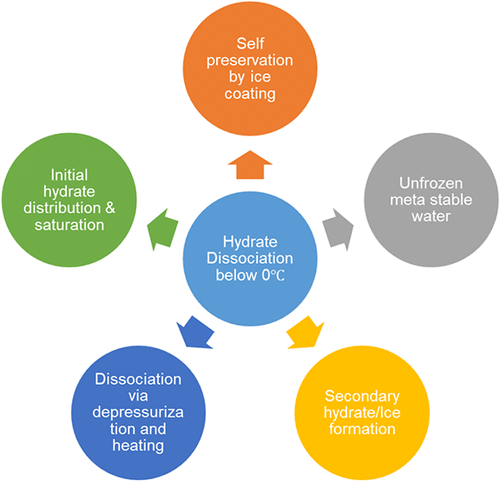当前位置:
X-MOL 学术
›
Energy Fuels
›
论文详情
Our official English website, www.x-mol.net, welcomes your feedback! (Note: you will need to create a separate account there.)
Pore-Scale Visualization of CH4 Gas Hydrate Dissociation under Permafrost Conditions
Energy & Fuels ( IF 5.3 ) Pub Date : 2021-01-06 , DOI: 10.1021/acs.energyfuels.0c03295 Jyoti Shanker Pandey 1 , Stian Almenningen 2 , Nicolas von Solms 1 , Geir Ersland 2
Energy & Fuels ( IF 5.3 ) Pub Date : 2021-01-06 , DOI: 10.1021/acs.energyfuels.0c03295 Jyoti Shanker Pandey 1 , Stian Almenningen 2 , Nicolas von Solms 1 , Geir Ersland 2
Affiliation

|
In this study, we investigate the effectiveness of combined pressure depletion and thermal stimulation to produce CH4 gas from CH4 gas hydrates at permafrost conditions. CH4 gas hydrate phase transitions were visualized using a high-pressure, water-wet, silicon-wafer micromodel with a pore network of actual sandstone rock. A set of eight experiments was performed in which CH4 gas hydrates were formed at a constant pressure between 60 and 85 bar and constant temperature between 0 and 4 °C. CH4 gas hydrates were then dissociated at a constant system temperature between −3 and −2 °C by pressure depletion to study the effect of hydrate and fluid saturation on the hydrate dissociation rate, self-preservation, and risk of ice formation. The hydrate dissociation rate and associated fluid flow were heavily affected by the hydrate saturation and initial hydrate distribution in the pore space. Specifically, the rate of CH4 gas production was low at T < 0 °C due to rapid formation of ice and secondary hydrate from the unfrozen liquid water that was liberated from the initial hydrate dissociation. The liberated CH4 gas was therefore immobilized and trapped and could not be produced without thermal stimulation. Thermal stimulation effectively melted the metastable hydrate and surrounding ice cover and thereby enhanced the CH4 gas production. Visual observation showed that self-preserved hydrates in the metastable state dissociated before ice at T < 0 °C, providing experimental evidence of recently discovered CH4 leaking from gas hydrates in permafrost-affected sediments. The reported results are important in order to understand and predict the influence of global warming on the dissociation of permafrost-affected gas hydrates.
中文翻译:

多年冻土条件下CH 4气体水合物离解的孔隙度可视化
在这项研究中,我们研究了在永久冻土条件下,结合压力消耗和热刺激从CH 4气体水合物中产生CH 4气体的有效性。使用具有实际砂岩岩石孔隙网络的高压,水湿硅晶圆模型,可以看到CH 4气体水合物的相变。进行了八组实验,其中在60至85 bar的恒定压力和0至4°C的恒定温度下形成CH 4气体水合物。通道4气体水合物然后在-3至-2°C的恒定系统温度下通过压力消耗而解离,以研究水合物和流体饱和度对水合物解离速率,自保存和结冰风险的影响。水合物的解离速率和相关的流体流动受到孔隙空间中水合物的饱和度和初始水合物分布的严重影响。具体而言,由于从最初的水合物分解中释放出来的未冻结的液态水迅速形成了冰和二次水合物,因此在T <0°C时,CH 4气体的产生速率较低。解放的CH 4因此,天然气被固定和捕获,没有热刺激就无法生产。热刺激有效地熔化了亚稳水合物和周围的冰盖,从而提高了CH 4气体的产量。肉眼观察表明,在T <0°C之前,亚稳状态的自保存水合物在冰之前解离,这提供了最近发现的永久冻土影响沉积物中气体水合物泄漏CH 4的实验证据。为了理解和预测全球变暖对永久冻土影响的天然气水合物离解的影响,报告的结果非常重要。
更新日期:2021-01-21
中文翻译:

多年冻土条件下CH 4气体水合物离解的孔隙度可视化
在这项研究中,我们研究了在永久冻土条件下,结合压力消耗和热刺激从CH 4气体水合物中产生CH 4气体的有效性。使用具有实际砂岩岩石孔隙网络的高压,水湿硅晶圆模型,可以看到CH 4气体水合物的相变。进行了八组实验,其中在60至85 bar的恒定压力和0至4°C的恒定温度下形成CH 4气体水合物。通道4气体水合物然后在-3至-2°C的恒定系统温度下通过压力消耗而解离,以研究水合物和流体饱和度对水合物解离速率,自保存和结冰风险的影响。水合物的解离速率和相关的流体流动受到孔隙空间中水合物的饱和度和初始水合物分布的严重影响。具体而言,由于从最初的水合物分解中释放出来的未冻结的液态水迅速形成了冰和二次水合物,因此在T <0°C时,CH 4气体的产生速率较低。解放的CH 4因此,天然气被固定和捕获,没有热刺激就无法生产。热刺激有效地熔化了亚稳水合物和周围的冰盖,从而提高了CH 4气体的产量。肉眼观察表明,在T <0°C之前,亚稳状态的自保存水合物在冰之前解离,这提供了最近发现的永久冻土影响沉积物中气体水合物泄漏CH 4的实验证据。为了理解和预测全球变暖对永久冻土影响的天然气水合物离解的影响,报告的结果非常重要。



























 京公网安备 11010802027423号
京公网安备 11010802027423号